How to Remove Palm Tree Stump
Palm Tree- A member of the Arecaceae family with its tall, slender trunk, large compound, fruit and flowers. There are over 2,00 species of palms that are found in tropical and subtropical regions all over the world that can be planted to represent the glory of warm, lowland wet areas.
Planting palm trees in the garden is a unique practice but due to several reasons such as wilting of plants or change of mind one may want to remove palm trees. But it can be more challenging to remove a palm tree stump than the whole plant.
Palm trees in general are plants of tropical areas that have the moderate ability to withstand stress greatly and have a shallow fibrous root system, spreading horizontally covering a larger area than the height of the plant, so uprooting them is not an option. So I would prefer to use the stump as a stool in the garden.
If I still have to remove the stump. I will seek help from experts or use decomposition methods to remove the stump. But these methods are expensive, laborious and time consuming. In this article I will explain different methods that can help to remove the palm tree stump.
Methods to Remove Palm Tree Stump
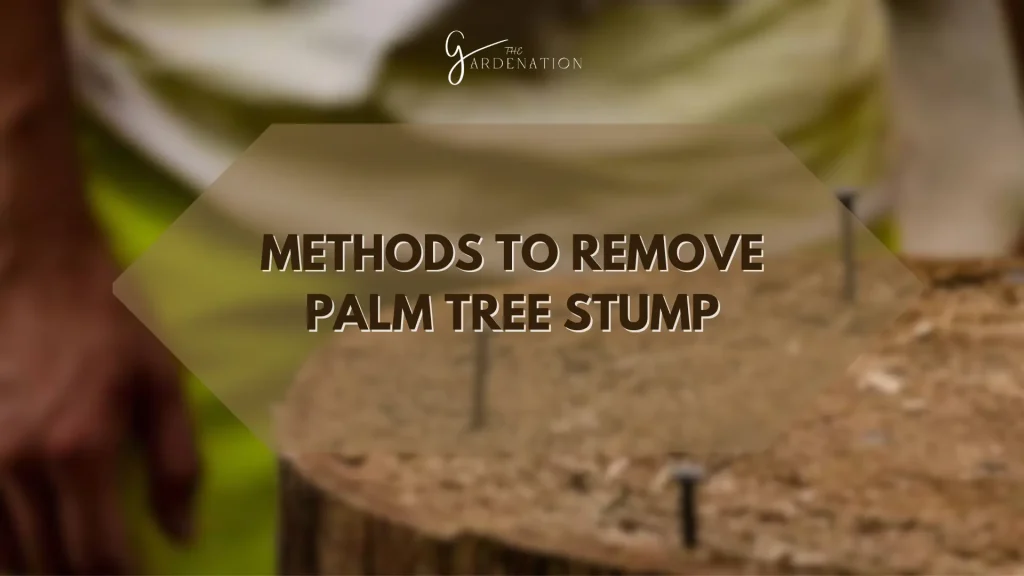
After cutting down the trees, a plane stool like stump of palm will be left depending upon the size of the tree. Although it is not easier to remove, if construction work has to be taken, the removal is necessary.
There are several methods to remove palm tree stump enlisted as;
- Manual Removal
- Stump Grinding
- Natural Decomposition
- Chemical Decomposition
- Burning
For more information about houseplants you can visit: Yellowing of Olive Tree Leaves
Before selecting the best method for the removal of stump, assess stump size and budget for best suitability. But one must also know that stump removal is not enough to stop the growth of plants as the root system can also encourage new growth.
So using growth inhibitors to kill the plant should be done to prevent new growth. I will note recommend uprooting the root system as root holds the soil in place. But in case of disease this step is also necessary as diseased root systems deteriorate soil health and affect nearby plants.
1. Manual Removing:
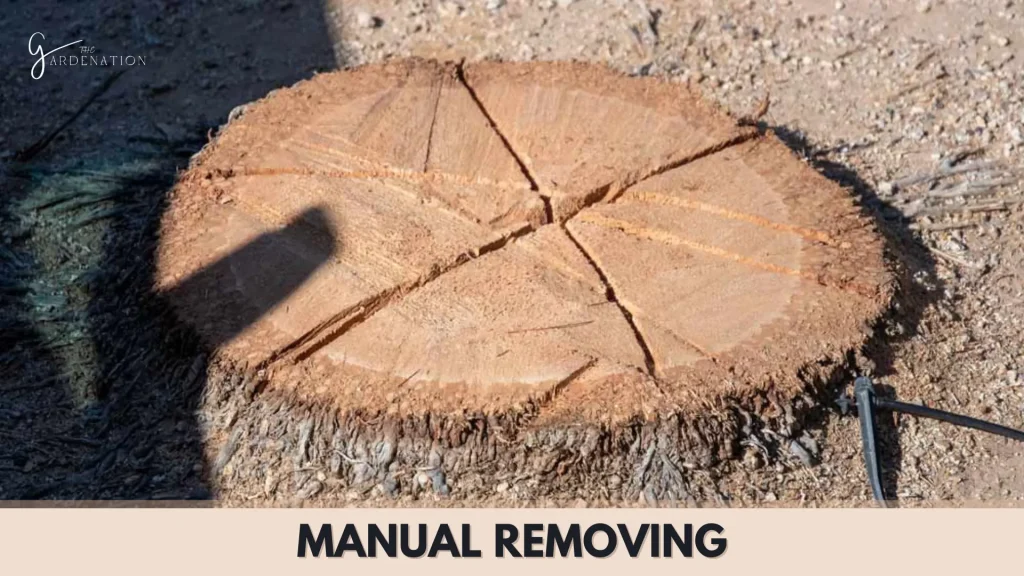
Manual removal is the most suitable method for the removal of smaller stumps with a shallow root system. For large stumps this is not recommended as it will be too labor intensive and time consuming.
Tools Needed
Following tools will be required for manual removal.
- Shovel
- Pickaxe
- Handsaw
- Ax
- Root Saw
- Protective Gear
Procedure:
- Before starting, assess the stump. Take a precise look at the target, estimate its size and width, clear the area for any debris and unwanted material to create a good work environment and then plan to take down the stump.
- It is preferred to moisten the soil day before the manual removal. Now begin by using a shovel to dig a trench around the stump, so that the main roots are exposed. Dig as deep as possible.
- After the main roots are exposed, use a root saw to cut them from the stump. The more roots are separated from the stump, the easier it will be to remove it.
- Then dig further downwards exposing the deeper roots. Create a space under the main stump making it less firmly attached to the ground.
- And the final step to remove the stump, insert the shovel underneath the loose stump and use leverage to remove it. For larger and firm stumps try rocking it side to side to loosen it further.
- If the stump is stubbornly attached, consider splitting it using an ax to divide it into smaller and easy to handle sections.
In this way stumps can be removed mechanically. But this method is physically tiring so one should be prepared to work hard. Try to remove and damage roots as much as possible to prevent any regrowth.
2. Stump Grinding:
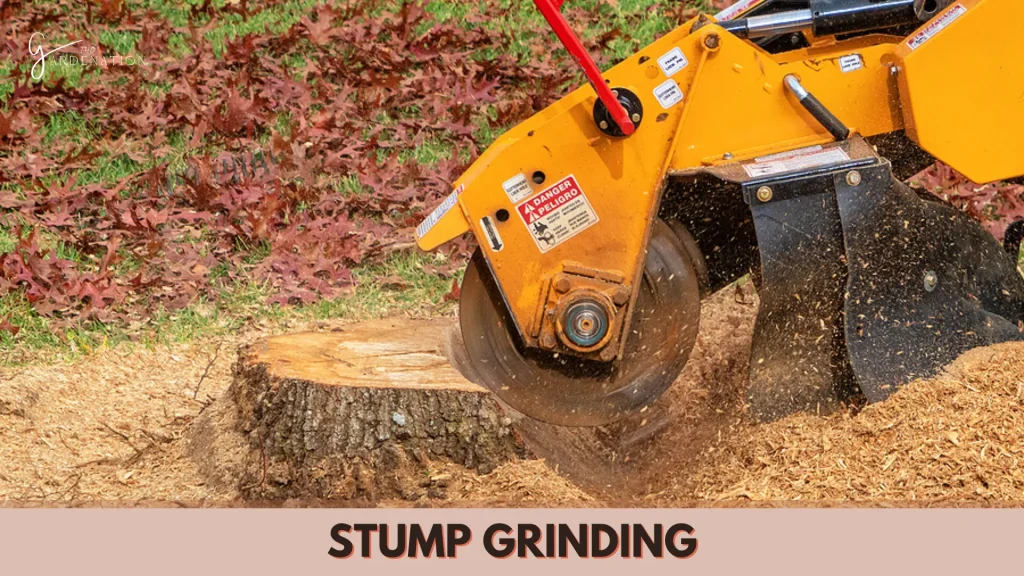
If the budget is not concerned, stump grinding is the best choice. As it is most efficient and safe for removing stumps. In this technique a specialized machine with a rotating grinder wheel is used that can easily break down the stumps into small pieces and leave behind less debris. This method is faster and takes only a couple of hours. It effectively removes the significant portion of stump along with roots of wide ranges of stump sizes.
Requirement
- A Stump Grinder
- Rotating grinder wheel with tungsten carbide-tipped teeth
- A professional equipment operator
Procedure
- First assess the area and clear away any material as it can cause unintentional harm.
- If the stump is very high off the ground, first lower its height using a saw for easier grinding.
- Carefully position the grinder to the stump
- Then engage the rotating wheel and slowly move it across the surface of the stump in a specific pattern. Keep moving the grinder until the stump is severed to the ground level, also break the main roots.
- The residual material is wood chips that are organic waste in nature and can be used as mulch around other trees.
- Fill the pot with soil after finishing the job.
3. Natural Decomposition
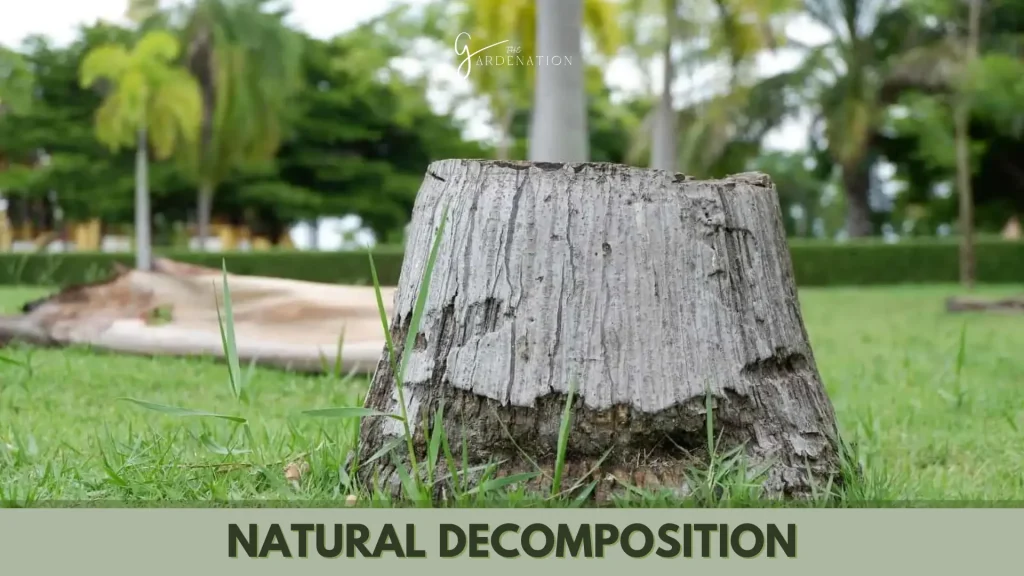
Natural decomposition is defined as the breaking down of organic material with time through the action of decomposers like bacteria, fungi and insects.
It is eco-friendly and the slowest method of removal of palm trees can take several years to complete depending on various factors.
These factors involves;
- Size and Type of Palm –Larger palms that grew slowly will decompose slowly. Compared to this smaller palms will take less time to decompose.
- Climate- Warmer and wetter climates favor the growth of microbes and accelerate the decomposition process as compared to colder, dry regions.
- Stump Preparation- Stump preparation for natural decomposition can significantly increase the process of decomposition. We have also discussed: 7 Causes of Fiddle Leaf Fig Leaf Curling. Do checkout!!
This is done as follows,
- Cut the stump as close to the ground as possible. This will increase the surface area to be decomposed to the microorganisms.
- Drill holes into the stumps. This aid will provide entry points for water, air and microorganism to penetrate more deeper into the wood.
- .Adding organic material around the stump will also enhance the growth of microbes thus increasing the rate of decomposition.
This method is eco-friendly and cost-effective as no power, labor and any chemical substance is used. Moreover, the decomposed stump adds organic matter to the soil increasing the overall fertility status of soil.
But still this method is not very effective as it is too time consuming, the decomposition may take several years and for this period of time the decomposing substance will give an ugly look to the place. Another risk involved in this method is that the stump may contain a potential to regrow. So even after years of wait one can fail the process. So manual removing or stump grinding are more suitable methods.
4. Chemical Decomposition
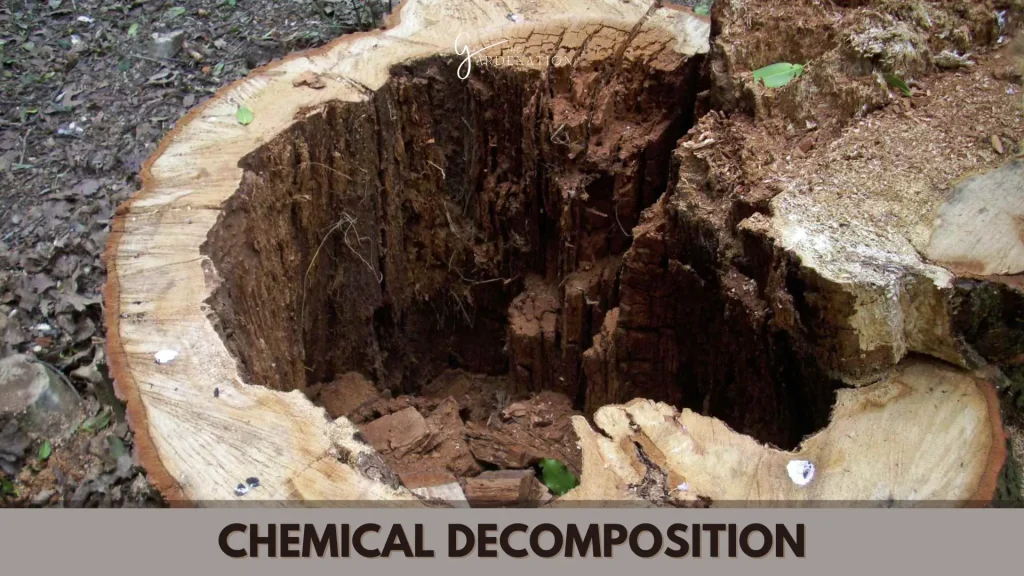
I discourage the use of chemical decomposition methods. As it involves the use of chemicals that are added to the stump to increase the rate of decomposition process. This process can cause toxicity in soil and is not environmentally friendly.
Chemical used– The most common chemical used for this purpose is “Potassium nitrate”. This chemical accelerates the natural decomposition process by providing nitrogen to the decaying organisms. Palm trees stump with dense wood might be resilient to the chemical decomposition as compared to the softer woods.
Procedure
- First cut the stump close to the ground and drill small holes inside its surface to allow easy penetration of chemicals inside the stump.
- Fill the holes with chemical granules and add water. Do this carefully and avoid spills or contact with skin. Manual must be read before doing this process.
- This process takes a few weeks or months depending on the size of stump and type of wood. More chemicals must be added during this time.
Precautions and Concern
- While using the chemicals one must always use personal protective equipment such as masks, gloves, glasses and long sleeves.
- Keep the chemical away from children and pets.
- Carefully dispose of the residues of chemicals used.
- Leaching down of the chemical is a serious concern as it can reach ground water and can cause contamination, eventually affecting local wildlife and plants.
- This method is not always effective as palm trees may not fully decompose.
- Without proper handling, chemicals can seriously harm the person playing with them.
Another important consideration is that some areas might have banned the use of chemicals for this purpose. So verify it to avoid any legal issues.
5. Burning of Stump:
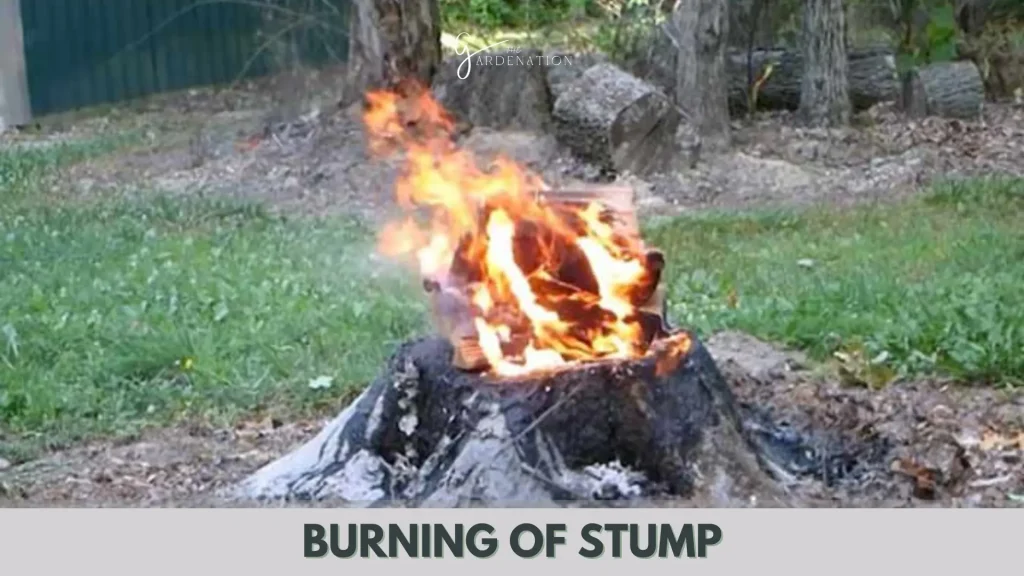
Last in this list, the burning process. I am strongly against this process as well as the local community and government of many regions has also banned this process. Removal of stump by this process can be quicker and easier as it banishes the stump in a few blinks.
Before moving towards the procedure first I will tell you the safety measures.
- Inform fire safety department before burning as it can cause fire hazard in case of bad luck.
- Don’t get close to the burning fire and never let the open fire unseen.
- Use permission before firing and keep the fire extinguisher at most convenient reach. So rushing and searching may not be needed.
Procedure
- Using a saw, cut the stump close to the ground.
- Drill small holes into the stump.
- Fill the holes with gasoline and avoid unnecessary volatilization of liquid. Allow the inside of the stump to soak down the liquid.
- Now put red hot coal on the holes with extreme caution and immediately retreat.
- Let the stump burn until it turns to ashes.
The average stump will take a few hours with the addition of black smoke, carbon and several unwanted chemical residues in the air harming the climate marking one’s role in global warming. So I would prefer to terminate this process and select to use grinder or manual methods.
Choosing the Right Method
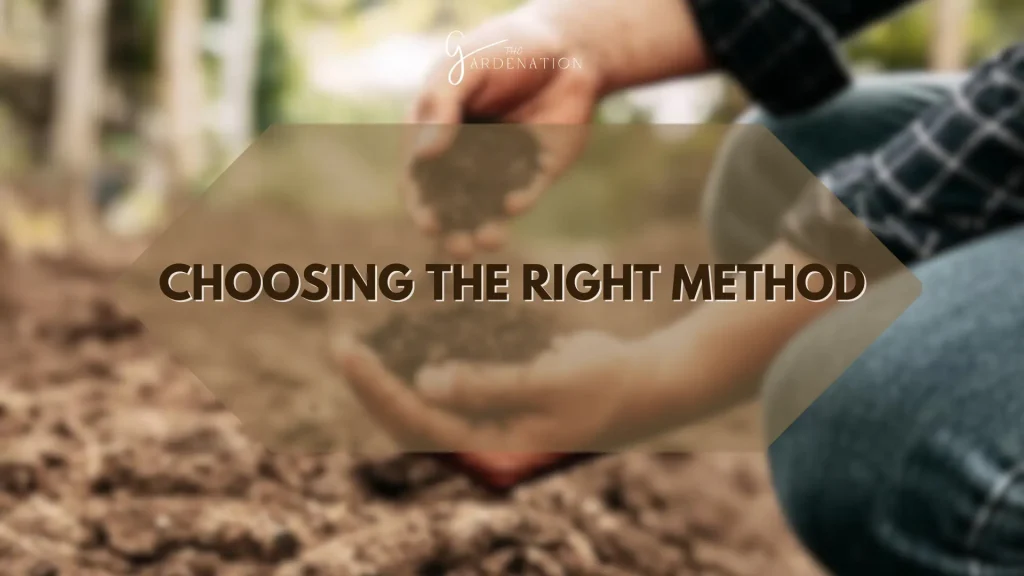
We have learnt all the basic methods for removing the stump, but it can be questioned which method is most suitable for my stump. So these are the key factors for assessing the most suitable method to remove palm tree stump.
- Size and Root System:
- Smaller stumps that have shallow roots are easier to remove and can be removed manually.
- While larger stumps having a well established root system will require mechanical intervention like grinding and other technical methods.
- Budget:
- If I have a budget problem I will choose manual digging, which is a budget friendly option.
- Grinding can be an expensive option, but for larger stamps it is the most efficient choice.
- Chemical methods might or might not be expensive depending upon the chemical used.
- Time and Environmental Impact:
- For the stump to be gone quickly, grinding is the fastest method. Other methods, manual and natural decomposition are time consuming.
- While selecting a method for removing a stump, one must not forget about the environment. Considering this natural decomposition is the most eco-friendly option.
- Chemicals used can affect the soil as well as the environment.
- Precautions
- Manual digging is labor intensive and if not done with proper expertise it can be injurious.
- Stump grinding and use of heavy machinery should only be done by the professionals as it can cause injury and property damage if not done with care.
- Using chemicals for this purpose should be done under proper guidance.
These are the factors that should be considered while selecting the method of palm stump removal. So assess the stump, consider the budget, evaluate time and environmental concerns, consider self abilities then make the right choice for removing the palm tree stump.
Frequently Asked Questions About How to Remove Palm Tree Stump
How Long Does a Palm Tree Take to Grow?
Depending upon the climate and given conditions different varieties of Palm stress take different periods for their growth. On average speaking, they are slow growing plants. Popular varieties like queen palm and foxtail palm typically have growth of 1-2 ft per year. During the early stage the growth is rapid but the growth slows down as the tree approaches maturity.
Are Palm Trees Highly Resilient Plants?
As compared to other trees, palm trees are not highly resilient plants. They are moderately tolerant and prefer warm climate areas such as tropical and subtropical. However due to their dense root system and waxy leaf surface they have adaptability to adapt to various stressors. They have great tolerance against drought and nutrient stress.
Conclusion
Removing palm tree stumps can be a challenging and time consuming process. But with proper approach and care this can be done properly. One must consider the stump size, budget and environmental concerns in this process. Manual removal, use of stump grinder are the suitable methods for stump removal as they are eco-friendly and take a few hours. On the other hand, natural decomposition is the most cost effective and environment supporting method but it takes too much time.
Other methods like burning and chemical decomposition are strongly discouraged due to their environmental hazardous effects. Moreover if not done with care they can also harm the technical persons.

